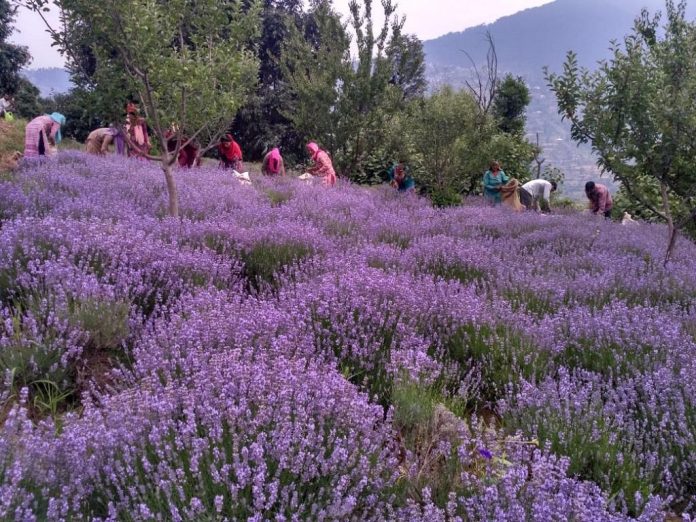Dr Jitendra Singh
The lavender success story is a textbook example of the powerful synergy between research-academia, industry, and local youth entrepreneurship, more of which is needed to take the country forward on the path to developed nation status.
India is now celebrated as the world’s third-largest start-up ecosystem, and boasts of some of the fastest-growing unicorns. This impressive expansion can be traced back to Prime Minister (PM) Narendra Modi’s clarion call of “Start-up India, stand up India” that he gave in 2016, in a speech delivered from the Red Fort. Since then, the number of start-ups has skyrocketed from just over 350-400 in 2014 to more than 130,000 in 2024, with each of the over 110 unicorns being the landmarks of this journey of enterprise in the country.
Amidst this entrepreneurial boom, India’s agricultural sector has also seen many transformative changes. Jammu and Kashmir (J&K), where agriculture employs close to 65% of the population and contributes around 27% to the Union Territory’s (UT) economy, has historically faced challenges. The region’s difficult terrain, monkey menace, and poor accessibility have limited extensive land utilisation, confining cultivation to traditional crops like rice, maize, wheat, and pulses – all of these being crops that often fail to provide sufficient revenue for farmers.
Under the Modi Government, the Council of Scientific and Industrial Research (CSIR), ministry of science and technology, launched the Jammu and Kashmir Aroma Arogya Gram (JAAG) project to address some of these agricultural challenges or offer a workaround through alternative crops. This ground-breaking initiative, popularly known as Aroma Mission, introduced the cultivation and processing of medicinal and aromatic plants (MAPs) using advanced CSIR technologies. This, in turn, has paved the way for India’s Purple Revolution.
The registered farmers were provided with free, high-quality planting material for half-an-acre of land and offered comprehensive training in cultivation, processing, and marketing MAPs. The initiative significantly boosted farmers’ income and created new employment opportunities in the rural areas of the UT.
The lavender cultivation aspect of this project, championed by young entrepreneurs, shattered the misconception that start-ups are largely, if not solely, confined to the areas of digital and information technology, with many youths leaving lucrative corporate jobs to engage in profitable lavender farming. This success story, originating from the small town of Bhaderwah in the remote, hilly district of Doda has led to the adoption of cultivation of lavender, has been taken up in other districts of J&K as well. Indeed, many Himalayan states, such as Uttarakhand, Himachal Pradesh, Arunachal Pradesh, and Nagaland, have started similar cultivation to give their farmers better incomes.
Every kind of support, including the appropriate technological support at every stage – right from cultivation to distillation at dedicated facilities for developing a wide range of lavender products to arranging market linkages with industry – was provided by CSIR. Today, over 1,300 hectares in J&K are under lavender cultivation, with notable progress in Ramnagar tehsil of Udhampur district. Awareness campaigns on the plant’s prospects for farm profitability have also been conducted in Mendhar, Poonch, and Rajouri.
The impact of this initiative has garnered national recognition. Bhaderwah’s lavender farms were prominently featured in this year’s Republic Day tableau at Kartavya Path, and these fields have become popular tourist attractions, further boosting the local economy.
In the 99th edition of his Mann Ki Baat address to the nation, PM Modi mentioned CSIR-Indian Institute of Integrative Medicine’s role in supporting lavender cultivation. This year, Doda district alone extracted 100 kg of fresh lavender oil, with farmers harvesting nearly 10 quintals of dry flowers, valued at ?800-1,000 per kg. One kanal (roughly equivalent to 506 square metres) of land produces 80-90 kg of flowers, and farmers have sold high-quality planting material worth ?45 lakh.
This initiative has not only enhanced the income of Jammu and Kashmir farmers but also has opened up a new vista for agri start-ups. It creates several opportunities in value-added medicinal and cosmetic products. The lavender success story is a textbook example of the powerful synergy between research-academia, industry, and local youth entrepreneurship, more of which is needed to take the country forward on the path to developed nation status.
(The author is Minister of State (Independent charge) for Science and Technology.)
Trending Now
E-Paper


